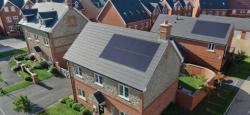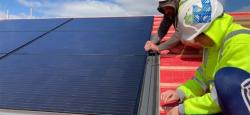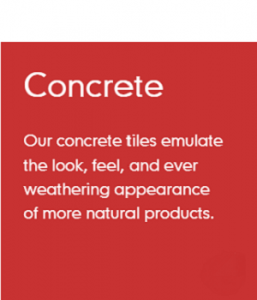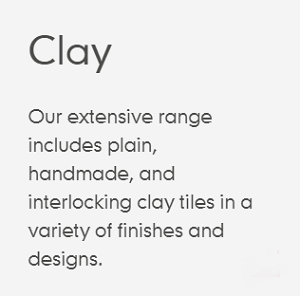MARLEY LTD
Suppliers of: Roof Tiles & Battens, Roofing Accessories, Cedar Shakes & Shingles, Renewable Solutions including Integrated PV Photovoltaic Panels for Pitched Roofs, EV Chargers, Solar Batteries & Inverters
Marley Range of Roofing Products & Systems
Marley is at the forefront of the roofing industry in the UK, with over 100 years of roofing expertise and heritage. We are the only UK manufacturer offering all elements of a roofing system including: Clay and concrete tiles, Shingles, Roofing accessories and BS 5534 compliant JB Red Batten.
Our complete pitched roofing solution comes with an unrivalled 15 year guarantee, offering you complete peace of mind. Our innovative and market-leading products also include a range of TDCA approved timber decking, which have been awarded the ’DeckMark’ accreditation.
All our products are supported by a wide range of easily accessible technical services and expert support for customers from all areas of the construction industry. We offer flexible, efficient service that saves our customers time and money on their projects and we’re even accredited by the Institute of Customer Service for our commitment to delivering the best possible customer experience. So whatever you need, we’re confident that we can provide the right solution and our online portal makes it quick and easy to get in touch with us.
Marley Roof Coverings
Marley SolarTile® roof-integrated solar tiles:
Marley SolarTile® is a roof-integrated solar panel solution, enhancing roof system specification with design flexibility, sleek aesthetics, industry leading wind and fire performance while acting as both a roof covering and electricity generating solution.
Clay Roof Tiles:
Marley offer a wide range of Clay roof Tiles and Accessories for all types of pitched roof construction
Concrete Roof Tiles:
Marley manufacture an extensive range of Concrete Roof Tiles and Accessories for all types of roof construction
Shingles & Shakes:
Marley offer a range of Western Red Cedar Shingles & Shakes which are fully sustainable and treated for durability
Roofing Base Layers
JB Red Batterns:
All JB Red roofing battens are supplied graded to meet the performance requirements of BS 5534.
Roofing Underlays:
Marley offer a wide range of roofing underlays, membranes and Accessories for all types of roof construction.
Roofing Finishes & Accessories
From Eaves Vents to Ridge Gullies, Marley offer an extensive range of Roof Finishes and Accessories for all types of roof construction.
Renewable Solutions:
NEW from Marley - The complete renewable energy system solution. We have enhanced our Solar Roof System offering to now include a wider package of renewable products, for a holistic approach to building more energy efficient, lower carbon homes. Our range of solar panels, Hybrid Inverters, Battery Storage, and EV Charging work effectively together, from one supplier. It’s per from the roof, through the home, to the road.
Further Technical information is available to download from the BPi Products Library or from the Manufacturer’s own website
Marley - Reviewing the new solar energy calculation in the Home Energy Model
 The procedure for calculating the energy performance of homes is set to change with the implementation of the Future Homes Standard in 2025. The new calculation, known as the Home Energy Model (HEM), will replace the current Standard Assessment Procedure (also known as SAP) and is likely to affect Energy Performance Certificates (EPCs) as well.
The procedure for calculating the energy performance of homes is set to change with the implementation of the Future Homes Standard in 2025. The new calculation, known as the Home Energy Model (HEM), will replace the current Standard Assessment Procedure (also known as SAP) and is likely to affect Energy Performance Certificates (EPCs) as well.
So, what can we expect from the new method? And how will it affect solar PV specification? As part of the industry consultation of the scheme, which ended in March, the government published a paper explaining how PV electricity generation and self-consumption would be calculated using the Home Energy Model. The BRE also developed a sample calculation tool. These gave a preview of what we can expect in 2025 and provided insight into how solar specification may change.
In this blog, we’ll share what we gleaned from these resources so you can start thinking about what the updates will mean for current and future projects.
What is the new Home Energy Model calculation?
The energy output of solar PV systems is calculated using the method set out in BS EN 15316-4-3:2017: Energy performance of buildings – method for calculation of system energy requirements and system efficiencies.
The energy output of a PV system is calculated using the hourly procedure (Method 6). The calculation is:
Eout = Solar energy ⋅ efficiency at STC (standard test conditions) ⋅ system performance factor
The performance factor is usually less than 1.0 and is affected by factors including power losses due to the temperature of the PV cells rising above 25°C, inverter losses, age degradation, soiled panels and wiring resistance.
Solar PV test conditions in the Home Energy Model
As part of the consultation for the Home Energy Model, case studies were provided to validate the calculations using real-world examples and lab tests. The results were then compared to the SAP 10.2 and Microgeneration Certification Scheme (MCS) calculations.
While variations between the different calculations were apparent, the similarities helped validate the proposed HEM methodology and indicated that HEM provided more accurate results. Let’s look at some of the variations and what they mean:
Panel ventilation – The amount of ventilation around a solar panel is a new variable not considered in SAP 10 or MCS calculations. Because solar PV electricity generation decreases as the panel's temperature rises, panels with open back faces (such as roof-mounted systems) should produce more energy than a similar panel with less ventilation. These are deemed to be “moderately ventilated” panels, while roof-integrated solar panels (such as the Marley SolarTile®) are considered “unventilated”. The difference in energy generation between these two ventilation methods, however, is thought to be between three and five percent, which is overall negligible to a roof PV system.
Orientation – The ideal orientation for UK solar panels is south-facing. As a panel’s orientation moves from south to north, its capacity for electricity generation decreases. However, the effect may not be as pronounced as previously thought since reflected or diffused light can still be used to generate electricity. The Home Energy Model has been adjusted to consider diffused and reflected light – it predicts around 64% more energy generation than MCS or SAP 10. This is a significant disagreement between the models and could indicate a problem with the Home Energy Model, so more research may be required.
Angle – In the UK, the ideal angle for a solar panel is between 35 and 45 degrees from horizontal. The HEM's results were closely aligned with SAP 10, with both models predicting a lower energy generation than MCS.
Location – The variation of solar yield was compared across five locations in England: Plymouth, Norwich, London, Birmingham and Manchester. Based on the dataset, the results for HEM were very similar to SAP 10.
Shading – This can come from various sources, such as trees and other buildings, and can change throughout the day as shadows move with the sun.
The government’s Home Energy Model consultation document provides additional details on the case study houses and their results.
Understanding energy demand in the Home Energy Model
Of course, the energy output of the solar panels is only part of the calculation. There’s also the question of energy demand. The HEM is modelled on half-hour timesteps, which are intended to account for real-time variation in the property’s PV generation and energy demand. Generated electricity is assumed to be allocated a priority of:
1. Household demands
2. Battery storage
3. PV diverter
4.Exported to the grid
Meanwhile, consumed electricity is assumed to be taken from solar first, then battery storage then the grid.
Compared to SAP 10, HEM predicts that self-consumption drops more quickly as the size of a solar installation increases – at least in scenarios with no battery storage of solar PV diverters. However, the government's report admits that a small dataset was used to establish the instantaneous self-consumption curve and that electrically heated dwellings were not included. Also, the use of half-hourly timesteps may introduce some degree of error. The report concludes: "This area would certainly benefit from further study in future."
Preparing for the FHS and Home Energy Model with Marley
While the Future Home Standard and Home Energy Models are still in development, the Marley team is working hard to keep up with the news and updates around the new standards. Our solar products, including the Marley SolarTile®, inverters, battery storage and EV chargers are all designed to provide a high level of efficiency and performance and our team is here to provide technical advice and calculations. To find out more, visit our dedicated renewable solutions page or contact us today.
What's the future of EPC ratings and how does it affect solar panel specification
 An Energy Performance Certificate (EPC) assesses a building’s energy efficiency, rating the property on a scale from A (most efficient) to G (least efficient). It also includes information about the building's energy use, typical energy costs and recommendations for improving efficiency.
An Energy Performance Certificate (EPC) assesses a building’s energy efficiency, rating the property on a scale from A (most efficient) to G (least efficient). It also includes information about the building's energy use, typical energy costs and recommendations for improving efficiency.
EPC ratings are intended to help prospective buyers or tenants understand the cost and environmental impact of heating, lighting and otherwise operating a property. But as the world increasingly recognises the effects of climate change and society starts to take steps towards a more sustainable future, what is in store for EPC ratings, and how will any changes affect solar PV specification?
A quick history of EPC ratings
EPCs were introduced in 2002 as part of the European Energy Performance of Buildings Directive (EPBD). They were phased into law in the UK starting in 2007, and by 2009, they were required for any commercial or residential property being bought, sold or rented across the UK.
Since their introduction, EPC ratings have played an essential role in improving energy efficiency and sustainability of the built environment. Because higher EPC ratings mean reduced running costs, as well as increased property value and appeal, they have encouraged property owners to invest in energy-saving measures such as solar panels, heat pumps, triple glazing and insulation.
The Future Homes Standard and what it means for EPC ratings
The Future Homes Standard (FHS) is set to be implemented in 2025. It will aim to ensure that new homes in England produce carbon emissions 75-80% lower than current levels. It will emphasise the use of low-carbon heating systems and renewable energy sources such as solar PV, as well as the increased energy efficiency of the building envelope. While the FHS will apply only to England, similar sweeping reforms are also being introduced in Scotland, Wales and Northern Ireland.
To meet the ambitious goals of the FHS, EPCs will need to evolve, and the introduction of the Home Energy Model (HEM) is a key part of this evolution.
The HEM will replace the Standard Assessment Procedure (SAP), which is currently used in the creation of an EPC. The HEM is a more sophisticated approach to evaluating a home’s energy performance. It takes a more granular approach to analysing a property's energy performance, looking at specific household appliance ratings, insulation specifications and the number of occupants. The result should be a more accurate and transparent assessment of a property’s energy use and efficiency.
At the time of writing (July 2024), it is not clear how the FHS or HEM will ultimately affect EPC ratings. The required minimum ratings could be changed, or an entirely new type of certificate could be created. Most industry experts, however, agree that changes to the EPC are inevitable with the implementation of the FHS in 2025.
How will changes to EPC ratings and the HEM affect solar panel specification?
While we await the final iteration of the Future Homes Standard in 2025, the specifics of how these evolving standards will affect solar panel specification are not certain. Still, we can make some assumptions based on resources released as part of the government’s consultation:
The Home Energy Model
Modelling PV electricity generation and calculating self-consumption within the Home Energy Model
The BRE’s sample HEM calculation tool
We believe the Future Homes Standard will lead to higher demand for solar panel installations. Solar PV may become a mandatory addition in new-build homes, helping to bring down energy bills and reducing our reliance on fossil fuels for heating, lighting, operating appliances and charging electric vehicles.
As part of this, solar panels are also likely to become a more integrated part of the home, working together with heat pumps, battery storage and smart home systems to use renewable energy more effectively.
Preparing for the future of EPCs and the HEM with Marley
The future of EPC ratings, driven by the Future Homes Standard and the Home Energy Model, promises more sustainable and energy-efficient housing. Solar panel specification will need to adapt to meet higher standards and integrate with other technologies, and here at Marley, we’re already working towards these goals.
At Marley we offer a full solar system for your project including the Marley SolarTile®, solar batteries inverters and EV chargers. To find out more, visit our dedicated renewable solutions page or contact us today.











